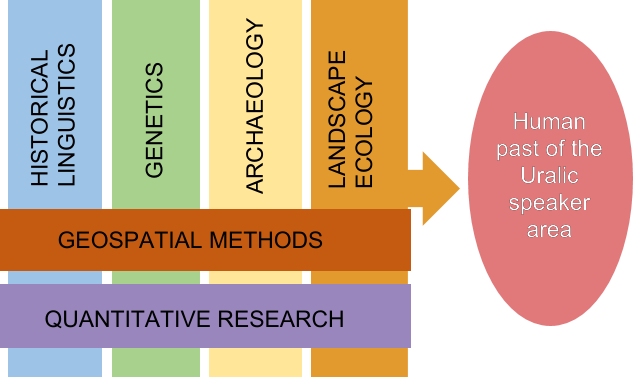Research
URKO explores the human past in the Uralic speaker area. Our work is truly multidisciplinary, combining materials, results and hypotheses from historical linguistics, genetics, archaeology and landscape ecology. By landscape ecology we mean the biogeographical properties of an area and the reference framework related to the spreading of organisms. These disciplines are combined brought together using quantitative techniques, especially geographical ones.

The dispersal of humans is visible in genetic, archaeological as well as linguistic data. Languages may spread together with their speakers, but it is also possible for the genetic and linguistic landscape to evolve at different times. Archaeology reveals cultural change, which may be connected to genetic and linguistic change, or it may not. One of URKO’s objectives is to shed light on whether genetic, linguistic and cultural change happens simultaneously or not. Using earlier research we can now study the expansion of humans using both (ancient) genetic and archaeological data, and also combine these results with hypotheses and data from historical linguistics.
The environment of humans consists of both linguistic and cultural environments as well as the natural environment. The spreading of other species is studied in relation to their environmental requirements. URKO also explores the dispersal of humans in relation to factors of the natural environment. Groundwork for this research has been laid through studies of how Stone Age humans have expanded (Oinonen et al. 2014), the development of Finnish dialect areas (Honkola et al. 2018) as well as how Uralic languages have diverged (Honkola et al. 2013).
The linguistic, cultural and genetic diversity of each moment of time depends on both the expansions of human groups, as well as contacts between the groups. The evolution of language families is partly a vertical process, i. e. sounds, words and grammatical features are transferred from an earlier population to a later one. On the other hand, the evolution of language is a strongly horizontal process, as linguistic and cultural features are also adopted from the environment. For example, language contact research of Uralic languages provides strong hypotheses of encounters between human populations. Lateral transmission is also not an unknown phenomenon in biological evolution. In fact, the transfer of genetic material between species has become an important research topic in evolutionary biology. In URKO we explore the model of “speciation” of language families by shedding light on the meaning of language contact to linguistic divergence.